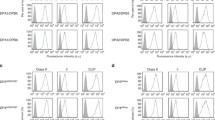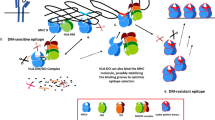Abstract
THE invariant chain, which associates with the major histocompatibility complex (MHC) class II molecules in the endoplasmic reticulum, serves two functions important in antigen processing. First, it prevents class II molecules from binding peptides in the early stages of intracellular transport1–3. Second, it contains a cytoplasmic signal that targets the class II-invariant chain complex to an acidic endosomal compartment4–6. Proteolytic cleavage and subsequent dissociation of the invariant chain then occurs7,8, allowing peptides derived from endocytosed proteins to bind to released class II molecules before their expression at the cell surface3. Certain human cell lines that are mutant in one or more MHC-linked genes are defective in class II-restricted antigen processing9–11. Here we show that in transfectants of one of these cell lines, T2, this deficiency results in the association of a large proportion of class II molecules with a nested set of invariant-chain-derived peptides (class II-associated invariant chain peptides, or CLIP). HLA-DR3 molecules isolated from T2 transfectants can be efficiently loaded with antigenic peptides by exposure to a low pH in vitro, perhaps reflecting the in vivo conditions in which peptides associate with class II molecules12–14. Addition of synthetic CLIP inhibits the loading process, indicating that CLIP may define the region of the invariant chain responsible for obstructing the class II binding site.
Similar content being viewed by others
References
Roche, P. A. & Cresswell, P. Nature 345, 615–618 (1990).
Teyton, L. et al. Nature 348, 39–44 (1990).
Roche, P. A. & Cresswell, P. Proc. natn. Acad. Sci. U.S.A. 88, 3150–3154 (1991).
Bakke, O. & Dobberstein, B. Cell 63, 707–716 (1990).
Lotteau, V. et al. Nature 348, 600–605 (1990).
Lamb, C. A., Yewdell, J. W., Bennink, J. R. & Cresswell, P. Proc. natn. Acad. Sci. U.S.A. 88, 5998–6002 (1991).
Blum, J. S. & Cresswell, P. Proc. natn. Acad. Sci. U.S.A. 85, 3975–3979 (1988).
Nguyen, Q. V., Knapp, W. & Humphreys, R. E. Hum. Immun. 24, 153–163 (1989).
Mellins, E. et al. Nature 343, 71–74 (1990).
Mellins, E., Kempin, S., Smith, L., Monji, T. & Pious, D. J. exp. Med. 174, 1607–1615 (1991).
Riberdy, J. & Cresswell, P. J. Immun. 148, 2586–2590 (1992).
Jensen, P. E. J. exp. Med. 171, 1779–1784 (1990).
Sadegh-Nasseri, S. & Germain, R. N. Nature 353, 167–170 (1991).
Germain, R. N. & Hendrix, L. R. Nature 353, 134–139 (1991).
Billing, R. J., Safani, M. & Peterson, P. A. J. Immun. 117, 1589–1593 (1976).
Cresswell, P. Eur. J. Immun. 7, 636–639 (1977).
Springer, T. A., Kaufman, J. F., Siddoway, L. A., Mann, D. L. & Strominger, J. L. J. biol. Chem. 252, 6201–6207 (1977).
Neefjes, J. J. & Ploegh, H. L. EMBO J. 11, 411–416 (1992).
Wei, M. L. & Cresswell, P. Nature 356, 443–446 (1992).
Strubin, M., Berte, C. & Mach, B. EMBO J. 5, 3483–3488 (1986).
Geluk, A., Bloemhoff, W., DeVries, R. R. P. & Ottenhoff, T. H. M. Eur. J. Immun. 22, 107–113 (1992).
Harding, C. V., Collins, D. S., Slot, J. W., Geuze, H. J. & Unanue, E. R. Cell 64, 393–401 (1991).
Rudensky, A. Y., Preston-Hurlburt, P., Hong, S. C., Barlow, A. & Janeway, C. Nature 353, 622–627 (1991).
Hunt, D. F. et al. Science 256, 1817–1820 (1992).
Chicz, R. M. et al. Nature 358, 764–768 (1992).
Lanzavecchia, A., Reid, P. A. & Watts, C. Nature 357, 249–252 (1992).
Glimcher, L. H., Polla, B. S., Poljak, A., Morton, C. C. & Mckean, D. J. J. Immun. 138, 1519–1523 (1987).
Lampson, L. A. & Levy, R. J. Immun. 125, 293–299 (1980).
Newcomb, J. R. & Cresswell, P. J. Immun. (in the press).
Author information
Authors and Affiliations
Rights and permissions
About this article
Cite this article
Riberdy, J., Newcomb, J., Surman, M. et al. HLA-DR molecules from an antigen-processing mutant cell line are associated with invariant chain peptides. Nature 360, 474–477 (1992). https://doi.org/10.1038/360474a0
Received:
Accepted:
Issue Date:
DOI: https://doi.org/10.1038/360474a0
- Springer Nature Limited
This article is cited by
-
Metatranscriptome of human lung microbial communities in a cohort of mechanically ventilated COVID-19 Omicron patients
Signal Transduction and Targeted Therapy (2023)
-
The transmembrane domain and luminal C-terminal region independently support invariant chain trimerization and assembly with MHCII into nonamers
BMC Immunology (2021)
-
N-Octanoyl-Dopamine inhibits cytokine production in activated T-cells and diminishes MHC-class-II expression as well as adhesion molecules in IFNγ-stimulated endothelial cells
Scientific Reports (2019)
-
Mass spectrometry–based identification of MHC-bound peptides for immunopeptidomics
Nature Protocols (2019)
-
What to do with HLA-DO/H-2O two decades later?
Immunogenetics (2019)





